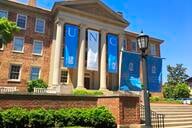You have /5 articles left.
Sign up for a free account or log in.

Istockphoto.com/FangXiaNuo
Over its decade-long history, College Unbound has developed an educational model that works for students who aren’t considered traditional but who are poised to become the future of college populations.
The nonprofit institution located in Rhode Island lacks a campus. But it has an 83 percent graduation rate for a student population that skews female, older, poorer and less white.
A case study released Wednesday by the American Council on Education looks at College Unbound’s journey through the accreditation process to identify barriers that could be hurting innovation that could most help future students.
College Unbound educates students through a high-touch program that includes personal learning plans, research projects and credits for achieving competencies. It offers a bachelor’s degree in organizational leadership and change, which is available only to students who hold some prior college credit. The college aims to keep tuition costs as close to the maximum Pell Grant allowance ($6,195 this year) as possible, while subsidizing additional costs with institutional scholarships. It keeps costs down by hiring only adjunct faculty members and leasing office space, rather than maintaining a campus.
The result appears to be a college that works for the most underserved students, who get a degree in less than three years, on average. Nearly 90 percent of the college’s alumni are employed full-time, and 71 percent of students’ research projects are put to use in the workplace or community.
The accreditation process for the college, however, included some struggles because of the unique model, according to Louis Soares, chief learning and innovation officer at ACE and co-author of the report “A College Unbound: Lessons on Innovation From a Student-Driven College’s Journey Through Regional Accreditation.”
“The biggest takeaway is that a triad structure … can support innovation, but it’s not ideally structured to do so,” Soares said. While the system did what it’s supposed to, he said, the process also slows down innovation.
Higher education's regulatory triad includes state, regional and federal accreditation and licensure processes. After College Unbound incorporated as a nonprofit in 2012, it sought state approval and eventually got it in 2015. Candidacy for accreditation from the New England Commission of Higher Education didn’t come until 2018. Only after that could the college apply to the federal Title IV program and receive Pell Grant funds, which it started receiving this fall.
One of the largest hurdles, Soares found, was finances. College Unbound didn’t anticipate such a long road to accreditation, and it had to fundraise repeatedly to sustain the organization and help students with tuition costs. The college initially submitted its report for regional accreditation in February 2016, but it was asked to wait and enroll a second cohort of students in the winter to prove its viability, delaying approval.
“I do think 10 years is too long,” Soares said. “We need a meaningfully consistent way to understand eligibility criteria” for speeding up the process in some cases.
While Soares said he doesn’t expect accreditors to “change on a dime” after encountering one unique institution, he hopes they always assess the process afterward, to see if something needs to be changed.
He supports adding provisional federal funding eligibility somewhere in the process, most likely between the periods of state approval and the sign-off by a regional accreditor. It could be similar to clinical trials in medicine, where the state or federal government provides funds once the institution passed one hurdle and is waiting for approval from the second.
Jamienne Studley, president of the WASC Senior College and University Commission, said the case study on College Unbound will be a helpful resource as accreditors continue trying to improve.
“I think it gives us a really valuable look at the application of standards to an institution that is creative and innovative and how well the standards work to evaluate the effectiveness of that institution,” Studley said of the case study. “One of the strengths of accreditation is broad concepts applied to very, very different, specific examples of educational pursuits and institutions.”
Institutional innovation happens more than people may realize, she said, and includes program-level innovations that may not get as much attention. Accreditors struggle every day to balance protecting students and taxpayers with “using standards as flexibly as possible” to allow in new ideas, Studley said. But “I think we’re getting better at it.”
For example, one recommendation in the case study is to connect new colleges with those that have been through the processes and can help them navigate it. WASC has an incubation project between Dominican University of California and the Make School that does just that.
Studley, a former Education Department official during the Obama administration, believes accreditors need to focus on being as clear on expectations as possible, as well as timely in responses, to help institutions save on time and costs. She noted that College Unbound said in the report that its experience got better with each level of accreditation as the college became more familiar with the processes.
Still, accreditors “always ask ourselves” if they are asking for too much information from smaller, newer colleges, Studley said. However, the federal government and the public have a “hunger” to know what’s going on in higher education.
As student demographics in higher education continue to shift and look more like those at College Unbound, Soares predicts that policies will change as well to match market demand. Many of the people he talked to for the report, including college presidents, accreditors and policy makers, said College Unbound is an innovative model that seems to work for that purpose.
“As we need to serve that population of folks, there aren’t models that are working,” he said. “As states need to serve them, the market will change that conversation.”




